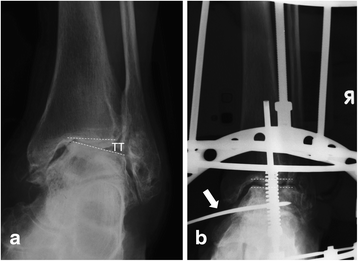Functional analysis of distraction arthroplasty in the treatment of ankle osteoarthritis
- PMID: 28126027
- PMCID: PMC5270240
- DOI: 10.1186/s13018-017-0519-x
Functional analysis of distraction arthroplasty in the treatment of ankle osteoarthritis
Abstract
Background: Ankle joint distraction arthroplasty (AJDA) is an alternative surgical procedure for the management of moderate to severe ankle osteoarthritis. However, the benefit of this procedure and failure relative factors are still in debate. The purpose of the current study was to evaluate the functional outcomes of AJDA in treatment of moderate to severe ankle OA and to evaluate the relative factors correlated with treatment failure.
Methods: Forty-six van Dijk stages II and III ankle osteoarthritis patients were included. Fifteen males and 31 females with a mean age of 54.8 (range, 42-71) years were followed with a mean of 42.8 (range, 24-68) months. The Ankle Osteoarthritis Scale (AOS) and American Orthopaedic Foot and Ankle Society (AOFAS) ankle-hindfoot score were used for functional outcome evaluation. The talar tilt (TT) angle and ankle joint space distance (AJSD) were evaluated. The risk ratio (RR) was calculated for each potential failure relative factor.
Results: The AOS and AOFAS scores were significantly improved at the last follow-up time (P < 0.01). The AJSD was improved in 61% of patients and with a significant improvement compared with the preoperative conditions (P < 0.01). The TT angle and range of motion reached no significant difference. The failure rate was 21.7%. Patients with large TT (≥5°) angle (RR = 3.81, 95% CI 1.28-11.33, P = 0.02) and obesity (RR = 3.58, 95% CI 1.30-9.89, P = 0.01) were found to have positive correlation with failure. No correlation was found between failure and gender, or overweight, or side, or age, or type and stage of OA, or pin infection.
Conclusions: The current study confirmed the early functional outcomes of ankle distraction arthroplasty. However, this procedure still has a relatively high failure rate, especially for those obese patients and patients with large TT angles.
Keywords: Ankle osteoarthritis; Arthroplasty; Distraction.
Figures



References
MeSH terms
LinkOut - more resources
Full Text Sources
Other Literature Sources
Medical

